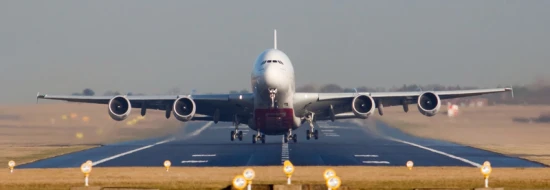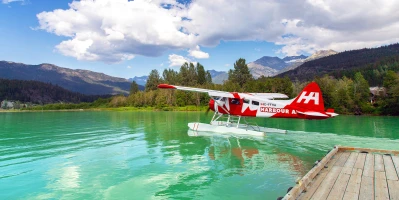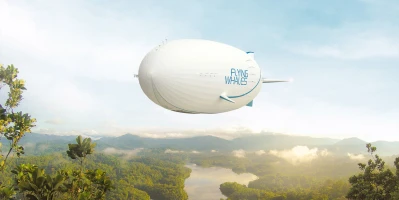aviation
Arctic cargo planes: Transport to the ends of the earth
There are no roads in the Arctic, so anything the people there need has to be brought in by cargo plane. Some of these aircraft will soon be 80 years old.
author: Andreas Spaeth | 8 mins reading time published on: 09.01.2024
author:
Andreas Spaeth
has been traveling the world as a freelance aviation journalist for over 25 years, visiting and writing about airlines and airports. He is frequently invited to appear on radio and TV programs to discuss current events in the sector.
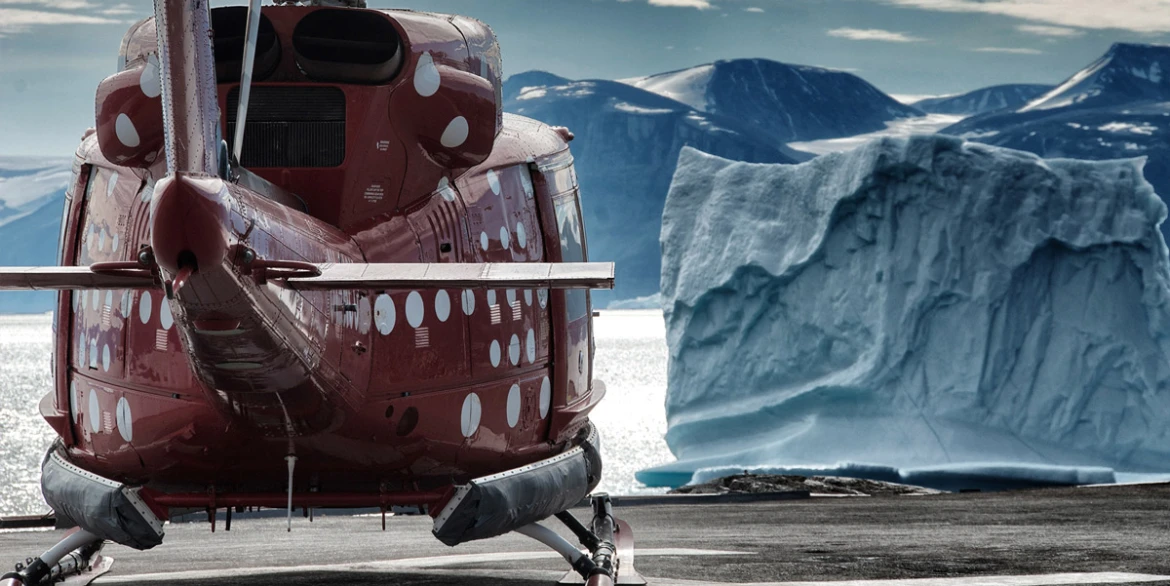
©Air Greenland
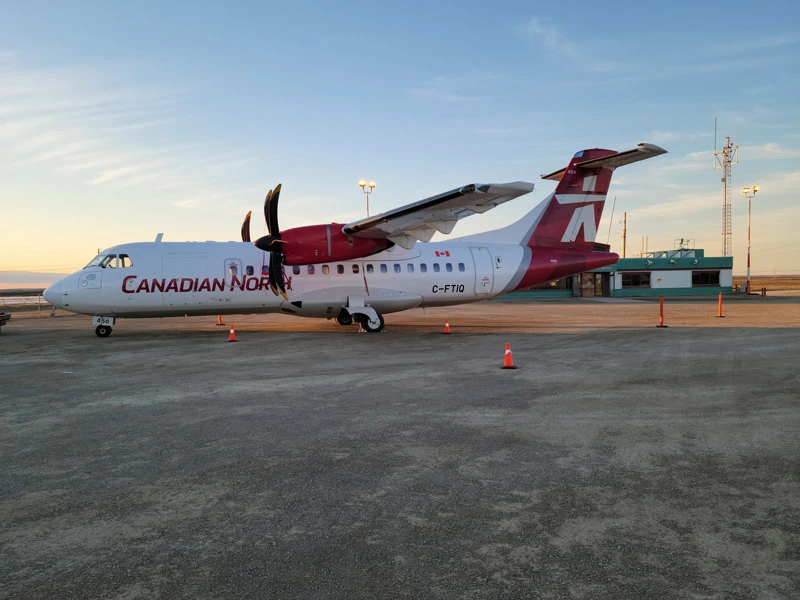

©Cambridge Bay Weather


©Cambridge Bay Weather
Life in Alaska: Food, building materials, online orders – everything is delivered by air.
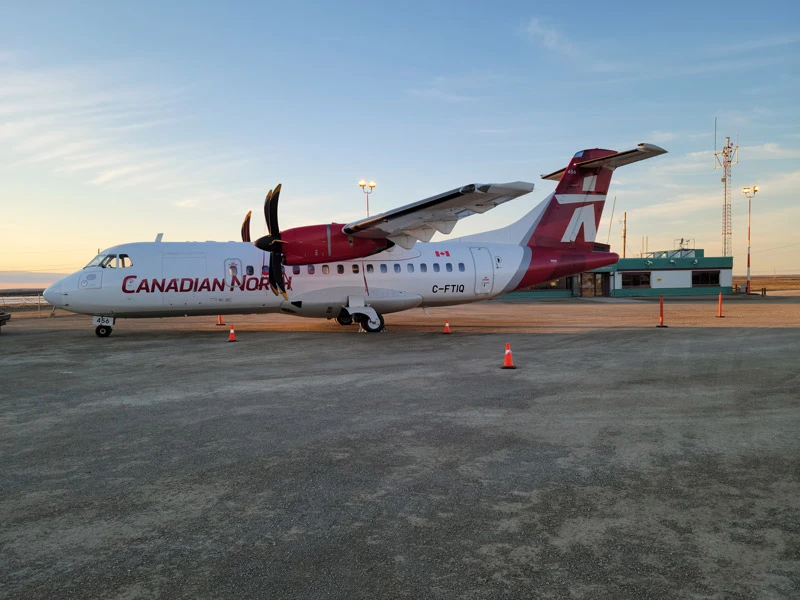
©Cambridge Bay Weather
A vast, largely deserted landscape in the northern reaches of the globe, often with extreme weather and immense distances. That’s an apt description of the Arctic. Just a few figures make it clear that life here would be unthinkable without the airplane: Alaska, the 49th state of the U.S., is larger than all of Western Europe, but has a population of only 730,000. Roughly 300,000 live outside the only two major cities. Or take Greenland, the largest island in the world, where the distance from north to south is a whopping 2,670 kilometers. A full 82 percent of its land mass is covered by a permanent sheet of ice, which can be up to 3,000 meters thick; only on the west coast are there ice-free patches. The Canadian north is one and a half times the size of Greenland and measures almost ten times the land mass of Germany. There are 118,000 people scattered across the region, which has just five airports with paved runways.
Air Greenland has the only widebody jet in the Arctic
The west coast of Greenland is home to most of the country’s 56,000 inhabitants, just about the same number as in the German town of Baden-Baden. Greenland has no roads, but Air Greenland flies to all 13 of the country’s commercial airfields. So far, only two of them can handle jets, but starting in 2024, this will go up to five. The only airport for widebody aircraft at the moment is Kangerlussuaq. Located at the head of a fjord in West Greenland, it opened as a U.S. military base in 1941. From here, Air Greenland operates its scheduled intercontinental service to Copenhagen, and since 2023, has been doing so with a fresh-from-the-factory Airbus A330neo—the only long-haul commercial jet stationed in the Arctic. Called Søndre Strømfjord in Danish, the hub offers access to all remote villages, often with hardly more than a good dozen inhabitants. Serving this purpose are the 47 heliports nationwide, where at least supply flights can land.

©Air Greenland
Bright red courier: Air Greenland mainly uses Dash-8s to provide connections within Greenland to the most important larger settlements, which often have only a few hundred inhabitants.
Online orders delivered to world’s end
Alaska’s main airport is in Anchorage and, oddly enough, is one of the world’s largest cargo airports. In 2022, it ranked third globally in terms of cargo volume handled and in transit at 3.4 million metric tons, behind Hong Kong and Memphis but ahead of Shanghai. This is partly because a large proportion of goods are delivered by air to the northernmost part of the U.S., but also because of the airport’s geographical location between East Asia and the U.S. east coast. Even the latest Boeing 747-8F freighters have to make their refueling stops here, right in the middle of one of the most important goods flows in the global economy.
Every day shortly before noon, the jumbo jets line up like pearls on a string on their approach to land. A Boeing 747 freighter touches down on one of the two runways every minute, each carrying up to 120 metric tons of cargo in the hold. Nowhere else in the world can you see so many of these mighty aircraft at once. They had taken off five, eight, or nine hours earlier from the U.S. east coast, Europe, or Asia. Barely two hours later, the apron is half empty again, the planes long since on their way to their actual destination, their bellies full not only with cargo moving from continent to continent, but also with goods for and from Alaska.

©Andreas Spaeth
Ends of the earth: Without air transport, life in many remote parts of Greenland would be impossible.
Washing machines at postal rates
In addition to the global cargo jet set, there are also small local companies here in Alaska and next door in northern Canada that specialize in delivery to the vast wilderness, supplying just about everything people need to live: from lumber and fuel to fresh fruits and medicines. Alaska has a unique system for this: even washing machines and other large appliances can be sent, or rather flown, to the farthest-flung communities at cheap postal rates. “We get the difference between the postal rates and the actual air freight costs back from the government, which is cheaper for them than building roads,” explains Edward Peebles, CEO of Warbelow’s Air. From Fairbanks, Alaska’s second-largest city, his company makes such supply flights to, say, Fort Yukon on the Yukon River, just 233 kilometers away.
Jumping into the car and arriving at your destination after two hours on a deserted road—in Alaska, it’s not that simple. People here are widely dispersed in many remote villages, but water is always nearby. This makes seaplanes the most common means of transportation. “The middle part of Alaska alone is bigger than California—but now imagine California without roads,” Peebles says. He and his company make a living from the fact that many people in Alaska can’t reach their homes by car. Even Alaska’s capital, Juneau, is accessible only by air or by boat. Warbelow’s Air operates a dozen six-seat Piper Navajos. “We’re the lifeline for many villages. Warbelow’s serves 28 towns from Fairbanks alone,” the CEO explains.
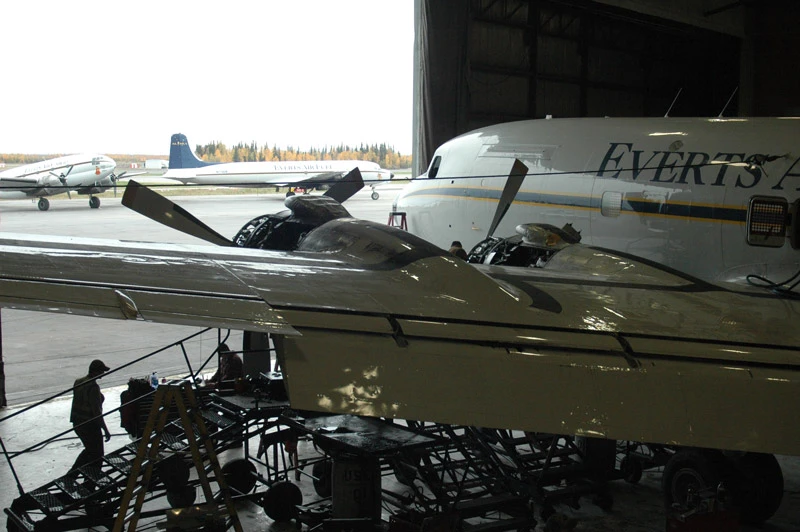
©Andreas Spaeth
Indestructible oldies: Everts Air in Fairbanks operates 1950s-era DC-6s and several 1944 Curtiss C-46s, which are still used today to fly cargo and fuel to settlements in the wilderness where no
roads lead.
Boxes of diapers for Fort Yukon
Outside the small aircraft terminal on this bright blue spring day, a Piper is being loaded for a flight to Fort Yukon. Stacks of boxes full of baby diapers, laundry detergent, and toys surround the aircraft. Pilot Richard carefully distributes everything in the cargo area located in the plane’s nose and behind the cabin. Even the small luggage compartments in the wings behind the two propellers get a couple rolls of toilet paper; all stowage possibilities are used. Each passenger can take up to 18 kilograms of luggage. The round-trip flight between Fairbanks and Fort Yukon costs more than 200 U.S. dollars—a lot of money for the inhabitants of the latter, most of whom are Alaskan Athabaskans. The community there, just 13 kilometers north of the Arctic Circle, has up to 800 residents in summer; in winter, sometimes only 200. Their livelihood is based on hunting and fishing. Just three passengers are booked today, so a few more boxes can be loaded and ensure the excellent capacity utilization at Warbelow’s Air as usual.


©Andreas Spaeth


©Andreas Spaeth
Vital supply route Twin-engine aircraft are a typical choice to guarantee the transport of people and goods between regional centers and remote Alaskan villages.
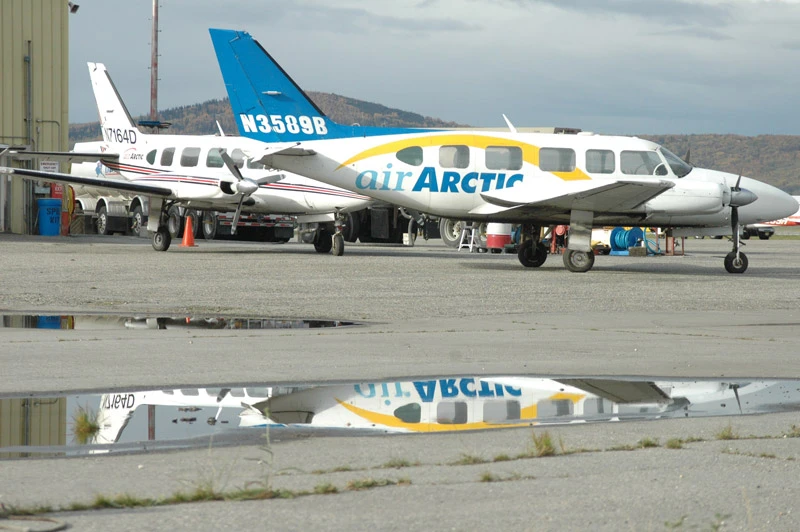
©Andreas Spaeth
Of course, large and heavy goods like construction materials or boats also have to be flown to each village. The little Pipers at Warbelow’s Air can’t manage that, but there are plenty of suitable aircraft just across from the General Aviation terminal at the Fairbanks airport. Alaska’s subsidy system and similar schemes in the Canadian Arctic have kept alive entire squadrons of piston-engine freighters from the 1940s and 1950s, aircraft that have long since been scrapped everywhere else in the world. Despite costly maintenance, these indestructible evergreens have an irreplaceable robustness in the far north. Right next to the hangar where Everts Air is currently servicing one of its 1954 DC-6s is a Curtiss C-46 cargo plane, nearly a decade older still: it was delivered to the U.S. Air Force in February 1945 and at the time was the largest twin-engine aircraft in the world.
The crew climbs aboard via a steep ladder; the massive hold is stacked full of sheetrock and cement bags for the far north. “No one can believe this plane was built in 1945,” says Rob Everts, head of Everts Air, who also flies the veteran aircraft himself. Just a few steps away, work is also being done on a C-46 of the same vintage, used by subsidiary Everts Air Fuel to fly fuel to remote areas. The name of the sturdy twin-engine aircraft says it all: “Hot Stuff.” For cargo pilots in Alaska, no task is too difficult: “I used to fly the DC-6 to the Aleutian Islands,” Everts recalls. “We had to use the road as a runway and could rarely touch down anyway because of the extreme weather—but when we did make it, it was like Christmas for the locals.”
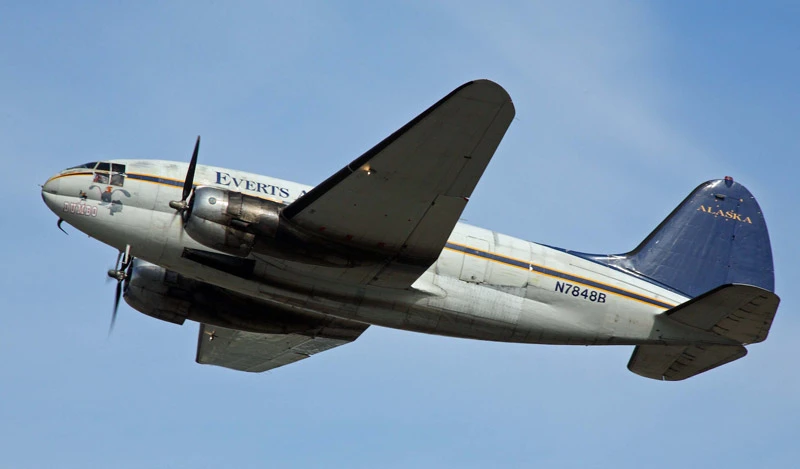
©Frank Kovalchek
Cargo planes: In much of the Arctic, they are the only link to the outside world.
Flying veteran aircraft in the far north
They say cold helps preserve things. This is definitely true of many aircraft from the past century that are no longer active anywhere in the world—except for the North American Arctic. Many aircraft fans make a pilgrimage to Alaska for that, but Rob Everts, head of Everts Air in Fairbanks, points out: “This isn’t a museum; we earn our money with these old aircraft. We use them because they are perfectly suited to the requirements here.” The oldest aircraft at Everts Air are the two Curtiss C-46s from 1945. Today, they are strange-looking monsters with tailwheels that can haul eight metric tons of bulky cargo into the wilderness.
Buffalo Airways in neighboring Whitehorse, Canada, made famous in the TV series Ice Pilots, still operates a C-46 built in 1944. Its long-lived sister aircraft, built in 1945 and with the registration C-FAVO, actually flew cargo for Lufthansa from 1964 to 1969. Buffalo Airways also operates four Lockheed L188 Electras, all over 65 years old; at the time, this model was the only American turboprop aircraft. The Electra was intended to replace the DC-6 in the late 1950s, but Everts Air and Buffalo Airways fly a half-dozen of this very same four-engine aircraft to this day. The oldest one dates from 1954. But even in the far north, you can’t shut yourself off from modernity completely. Buffalo Airways introduced its first jet in 2023: a Boeing 737-300 built in 1989 and converted to a freighter. And their colleagues at Canada North, the largest passenger airline in the Arctic, are looking at the French “Flying Whales” airship project for future cargo transport in the northern latitudes.



